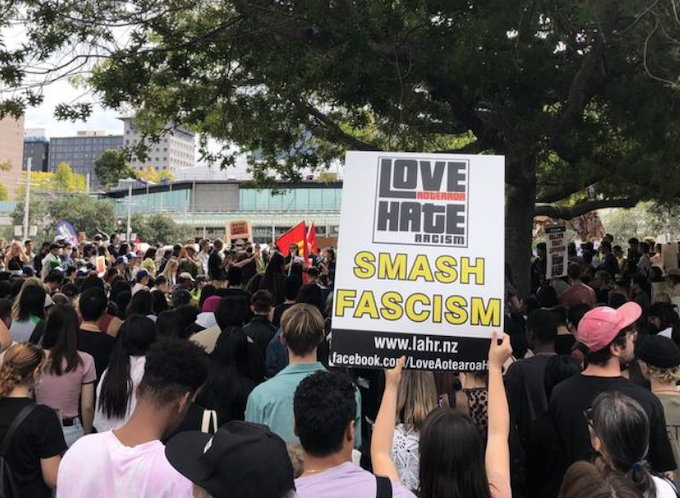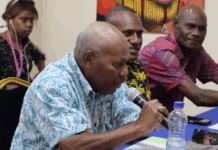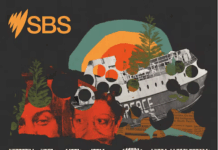
ANALYSIS: By Tony Fala
PART 2: WS storytelling in more detail
In part one of my article on White Supremacy (WS), I articulated some of the features of the WS network in Aotearoa and positioned this framework along a spectrum. I attempted to introduce readers to a WS spectrum so people could better understand and then respond to the phenomenon of supremacy in Aotearoa.
In the first article, I argued that one of the features of the emergent WS framework in Aotearoa involved the development of narratives. This second article seeks to explore the question of WS storytelling in more detail.
Moreover, this article seeks to situate WS narratives within a storytelling framework to enable different communities to read supremacist messages as stories, contextualise them, and respond to them — from within the various standing places different communities occupy in time and space in Aotearoa.
- READ MORE: Covid disinformation and extremism are on the rise in New Zealand. What are the risks of it turning violent?
- The protest that revealed a new, ugly, dangerous side to our country
- Ardern loses the gloss as New Zealanders protest about covid restrictions
- Other reports on covid disinformation
White Supremacists (WS) have been very effective in articulating their narratives in a variety of ways during the covid-19 lockdown period. WS narratives are being disseminated across a range of media simultaneously.
The stories have been deployed in alternative media broadcasts; emails; Facebook comments, links, memes, posts, stories, video of live events; internet sites; political party press statements, political party policy documents, and even non-mainstream television shows to disseminate their stories on a wide array of issues.
Whether short or long, serious, or humorous, visual, or written, WS advocates are telling their stories and teaching their “lessons”. Such stories are being affirmed and disseminated in freedom marches and anti-vax protests — as videos of such gatherings attest.
WS messaging is occurring across multiple platforms as tracked by Hannah, Hattotuwa, and Taylor of The Disinformation Project.
Disseminating narratives
WS individuals, groups, and organisations are disseminating narratives to push their agendas. These stories include ones that illuminate:
- contempt for Te Tiriti;
- rejection of power sharing between Pakeha and Māori as articulated in Te Tiriti;
- antagonism towards Māori communities historical experience of colonialism;
- privileging of a mythology of peaceful and just race relations between Māori and Pakeha- thereby simultaneously erasing the racism experienced by Asians, Africans, Pacific peoples, and others in this land;
- desire by political parties in policies to end “race”-based privileges for Māori in health, law, or at the United Nations;
- vilification of the NZ Labour Party as “socialistic”;
- attacks on Māori activist, community, political, and scholarly leaders — and attempts to separate leaders from their peoples;
- attacks on the United Nations and governments as “cabals of evil”;
- contempt for migrants and migrant rights;
- lauding of former US President Donald Trump, Republicans, or QAnon leader, “Q”; and
- intolerance and bigotry expressed towards Māori, Jews, Muslims, and other communities.
I have identified only 11 narratives that privilege WS in the list above. There are many other stories contributing to what is a diverse WS movement.
I cannot articulate a framework illuminating how WS advocates are using video, meme, comments, or policy documents aesthetics to tell their stories because I do not have the space or time here. But what I can offer is an analysis of WS storytelling to empower communities to “close read” the stories WS supporters are telling in their deployment of different media.
We need to develop frameworks to intercept, assess, and respond to these narratives, so communities have the means of defending their lives, mana, and the sanctity of their communal stories in the face of a barrage of WS storytelling.
African, Arab, Asian, Jewish, Māori, Pacific, Palestinian, and Pakeha communities are grounded in (1) rich cultures; (2) values; (3) community spirit; (4) interpretive traditions; (5) reading traditions; (6) oral and communal storytelling traditions; and (7) wisdom and insight.
Deploy learning
I invite readers from different cultures to deploy their learning when considering the following issues concerning WS.
The first narrative I identified regarding WS frameworks above is the story of the contempt for Te Tiriti. We could ask:
- is the story of contempt for Te Tiriti based upon fact?
- is this story true?
- what beliefs about Māori and Te Tiriti must people hold to accept this story as “true?”
- who are the authors of the story of contempt for Te Tiriti?
- where do the stories come from?
- has this story been told in Aotearoa before covid 19-lockdowns in 2021?
- where is this story circulating?
- is this story being used to organise opposition to Māori communities?
- does this story uphold the mana of Māori communities?
- what values underpin this story?
- is this story connected to WS narratives coming from the US, Europe, Australia, or other foreign countries?
- is this story connected to other WS narratives circulating in contemporary Aotearoa today?
- is this story one being used to attack Māori community rights?
- what is the plot of the story of contempt for Te Tiriti?
- are there variations to the plot of this story?
- who are the key characters of this story?
- who are the heroes and who the villains in this story?
- what lessons does the story teach us?
- does this story resonate with the community beliefs, cultures, and values of many different Aotearoa communities?
- does this story attempt to erase the narratives of Māori communities?
- does this story attempt to distort the experience of Māori communities?
- does this story prevent the emergence of Māori community narratives?
- does this story foster better relationships between Māori and other communities in Aotearoa? and
- is this story good for communities, Aotearoa, and the Pacific?
I hope different communities will develop their own reading strategies in response to these problems. Similarly, it is to be hoped that communities will also develop their own questions in response to WS narratives — and the “truths” embedded these stories.
Remembering Said’s words
The words of the Palestinian-American activist, commentator, scholar, and writer Edward Said are apt here. The late Professor Said once wrote in his famed essay, “Permission to Narrate”, that, “Facts do not at all speak for themselves, but require a socially acceptable narrative to absorb, sustain and circulate them. Such a narrative has to have a beginning and end…”
We should remember Said’s words as we defend the narratives of Māori and all other communities against the stories of WS.
Covid-19 lockdowns have brought hardship to the door of many folks in Aotearoa. Nonetheless, stories of community service, kindness, unselfishness, and care abound in Aotearoa today.
Narratives of community concern, fellowship, generosity, service, respect, and tolerance underpin the labour of many — particularly those working in the health sector. These narratives are being written by all the peoples of Aotearoa together.
Māori narratives of community service have been particularly inspiring during this difficult lockdown period. People should reflect upon whether the WS narratives uphold the dignity of Kiwis of all cultures — or whether these narratives uphold the most antagonistic features of settler colonialism in Aotearoa.
In conclusion, I have ancestry from different parts of the Moana (Pacific) as well as ancestors from Europe. I am as proud of my Highland Clan Stewart heritage today as I am of my other ancestors.
I did not know my Pakeha family well and felt ashamed and antagonistic towards this ancestry when I was younger. These feelings changed when I spent time with Pakeha family in the South Island.
I admire the staunch pride of my Scottish ancestors, especially those clan members who fought against English invaders. I believe there is much to respect in Pakeha culture.
I also believe Pakeha can be proud of their ancestors and still live beyond the ideology that says their culture is superior and should rule over Tangata Whenua in this land. Pakeha culture need not be white supremacist culture.
Pakeha and Māori can respect one another and move forwards as partners under Te Tiriti. This is a narrative worth supporting moving into the future.
Tony Fala wishes to acknowledge the lives and work of Amiri Baraka, Bantu Stephen Biko, Frantz Fanon, and Edward Said as the inspiration for this article. Finally, Fala wishes to acknowledge his good friend Emeritus Professor Roger Horrocks. Horrocks was a superlative anti-Vietnam War student protest leader, scholar, and teacher. He taught Fala, alongside generations of other students, how to close read works of culture, film, history, media, literature, and television with commitment, dedication, and alofa. Horrocks is also one of the humblest people the author knows. Fala holds a PhD from the University of Auckland in Media, Film and Television.













































